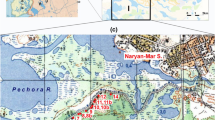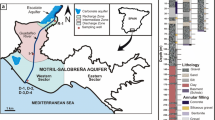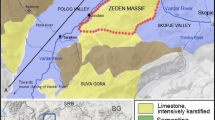Abstract
A tide-influenced two-layer aquifer system in northern Germany was investigated using environmental dating tracers (3H, 39Ar, 14C), the noble gas isotopes 3He, 4He and Ne. The study area is a marshland at the River Ems estuary, exposed to regular flooding until AD 1000. The construction of dykes, artificial land drainage and groundwater abstraction define the hydraulic gradient. The aquifer depicts a pronounced age stratification with depth. Tritium concentrations above 0.03 TU are found only in the top 30 m. Two tritium-free samples between 20 and 30 m depth show 39Ar ages of 130 and 250 years. Below a clay layer–about 50 m below surface level (mbsl)–all analysed samples are 39Ar free and, thus, older than 900 years. The initial 14C activities were about 70 pmC. Resulting 14C ages increase with depth and increase up to 9,000 years, in agreement with minimal 39Ar ages. Concentrations of radiogenic 4He correlate with 14C ages. Samples in a mid-depth range (20–70 mbsl) show significant gas loss. The gas loss is assigned to recharge in a methane producing environment. Deduced 4He ages were used to assign this water to a infiltration period of about AD 1000.
Résumé
Un système aquifère bi-couche d’Allemagne du Nord influencé par la marée a été étudié en utilisant pour la datation des traceurs environnementaux (3H, 39Ar, 14C), les isotopes de gaz rare 3He et 4He et Ne. L’aire d’étude est un pays de marais à l’estuaire de la rivière Ems, soumis à une marée régulière jusqu’en l’an 1000. La construction de digues, le drainage du terrain et le prélèvement sur nappe déterminent le gradient hydraulique. L’aquifère montre en profondeur une stratification bien soulignée par les âges. Des concentrations en tritium supérieures à 0.03 TU sont notées seulement sur les 30 m de tête. Entre 20 et 30 m de profondeur, deux échantillons sans tritium sont datés de 130 et 250 ans par 39Ar. Sous un niveau d’argile (à environ 50 m sous le niveau de la mer), tous les échantillons analysés sont sans 39Ar et donc plus âgés que 900 ans. Les activités initiales 14C “sont environ 70 pmC. Les ages 14C résultants s’accroissent avec la profondeur jusqu’à 9000 ans, en accord avec les ages 39Ar. Les concentrations de 4He radiogénique sont corrélées avec les âges 14C. A profondeur moyenne (20 – 70 m sous le niveau marin), des échantillons montrent une importante perte de gaz, attribuée à une recharge en méthane produit par l’environnement. Des âges 4He datent la période d’infiltration de l’eau aux environs de l’an 1000.
Resumen
Se investigó un sistema acuífero de dos capas en el Norte de Alemania influenciado por la marea usando trazadores de datación ambiental (3H, 39Ar, 14C), los isótopos de los gases nobles 3He y 4He, y Ne. El área de estudio es un terreno de marisma en el estuario del río Ems, expuesto a inundaciones regulares hasta el año 1000. La construcción de diques, drenajes artificiales de los terrenos y la extracción de aguas subterráneas determinan el gradiente hidráulico. El acuífero muestra una pronunciada estratificación de edad con la profundidad. Las concentraciones de tritio por encima de 0.03 TU se encuentran sólo en los 30 m superiores. Dos muestras libres de tritio entre 20 y 30 m de profundidad mostraron edades de 39Ar de 130 años y 250 años. Por debajo de una capa de arcilla (alrededor de 50 m debajo del nivel de la superficie (mbsl)) todas las muestras analizadas resultaron estar libres de 39Ar y por lo tanto con una antigüedad mayor a 900 años. Las actividades iniciales de 14C estuvieron alrededor de 70 pmC. Las edades de 14C resultantes aumentan con la profundidad y se incrementan hasta 9000 años, en acuerdo con las edades mínimas de 39Ar. Las concentraciones de 4He radiogénico se correlacionan con las edades de 14C. Las muestras en un intervalo de profundidades medias (20 – 70 mbsl) muestran una pérdida de gas significativa. La pérdida de gas se asignó a la recarga en un ambiente productor de metano. Las edades de 4He deducidas fueron usadas para asignar esta agua a un período de infiltración de alrededor del año 1000.
摘要
利用环境示踪剂(3H, 39Ar, 14C), 惰性气体同位素3He、4He和 Ne研究了德国北部的一个受潮汐影响的双层含水层。研究区位于埃姆斯河口的一个沼泽区域, 这里在公元1000年前经常泛滥。防洪堤的结构、人造的地面排水渠道、以及地下水的开采决定了该区的水力梯度。该含水层显示出一个随深度变化的明显的年龄分层。仅仅在顶部的30m发现超过0.03TU的氚。在20m和30m深度之间的两个无氚样品显示39Ar的年龄为130年和250年。在粘土层(大约在地表以下50m处)以下, 所有的分析样品中均无39Ar, 所以年龄均超过900年。最初的14C浓度大约是70 pmC。结果表明14C的年龄随着深度的增加而增加, 直至9000年, 并与39Ar的最小年龄一致。放射性的4He的浓度与14C的年龄相吻合。中间深度样品(20m到70m之间)气体亏损严重。气体的亏损标志着在一个产生甲烷的环境中接受补给。依据4He推断的年龄表明该水是公元1000年时渗透的水。
Resumo
Um sistema aquífero de duas camadas sujeito a influência de maré foi investigado através do uso de traçadores de idade (3H, 39Ar, 14C), de isótopos de gases nobres 3He e 4He, e de Ne. A área de estudo é um terreno pantanoso no estuário do rio Ems exposta a cheias regulares até 1000 AD. O gradiente hidráulico é definido pelos diques construídos, pela drenagem artificial dos solos e pela extracção de águas subterrâneas. O aquífero apresenta uma acentuada estratificação de idades em profundidade. Apenas nos primeiros 30 m se observam concentrações de trítio acima de 0.03 TU. Duas amostras sem trítio entre os 20 e os 30 m apresentam idades para 39Ar de 130 anos e de 250 anos. Sob uma camada de argila (localizada a cerca de 50 m abaixo da superfície do terreno (mast)) em nenhuma das amostras analisadas foi observado 39Ar e, portanto, têm idades superiores a 900 anos. As actividades iniciais de 14C são de cerca de 70 pmC. As idades de 14C aumentam em profundidade até um valor de 9000 anos, em concordância com idades mínimas de 39Ar. As concentrações de 4He radiogénico correlacionam-se com as idades de 14C. As amostras recolhidas num nível intermédio de profundidade (entre 20 – 70 mast) apresentam uma significativa perda de gás. A perda de gás é atribuída a uma recarga num ambiente com produção de metano. As idades deduzidas do 4He foram utilizadas para atribuir esta água a um período de infiltração cerca de 1000 AD.












Similar content being viewed by others
References
Aeschbach-Hertig W, Peeters F, Beyerle U, Kipfer R (1999) Interpretation of dissolved atmospheric noble gases in natural waters. Water Resour Res 35(9):2779–2792
Aeschbach-Hertig W, El-Gamal H, Wieser M, Palcsu L (2008) Modeling excess air and degassing in groundwater by equilibrium partitioning with a gas phase. Water Resour Res 44:W08449. doi:10.1029/2007WR006454
Andrews JN, Lee DJ (1979) Inert gases in groundwater from the Bunter Sandstone of England as indicators of age and palaeoclimatic trends. J Hydrol 41:223–252
Andrews JN, Davis SN, Fabryka-Martin J, Fontes J-C, Lehmann BE, Loosli HH, Michelot J-L, Moser H, Smith B, Wolf M (1989) The in situ production of radioisotopes in rock matrices with particular reference to the Stripa granite. Geochim Cosmochim Acta 53:1803–1815
Aravena R, Wassenaar LI, Plummer LN (1995) Estimating 14C groundwater ages in a methanogenic aquifer. Water Resour Res 31(9):2307–2317
Balabane M, Galimov E, Hermann M, Letolle R (1987) Hydrogen and carbon isotope fractionation during experimental production of bacterial methane. Org Geochem 11:115–119
Benson BB, Krause D (1980) Isotope fractionation of helium during solution: a probe for the liquid state. J Sol Chem 9:895–909
Beyerle U, Aeschbach-Hertig W, Hofer M, Imboden D M, Baur H, Kipfer R (1999) Infiltration of river water to a shallow aquifer investigated with 3H/3He, noble gases and CFCs. J Hydrol 220:169–185
Brennwald MS, Kipfer R, Imboden DM (2005) Release of gas bubbles from lake sediment traced by noble gas isotopes in the sediment pore water. Earth Planet Sci Lett 235:31–44
Castro MC, Stute M, Schlosser P (2000) Comparison of 4He ages and 14C ages in simple aquifer systems: implications for groundwater flow and chronologies. Appl Geochem 15:1137–1167
Charman DJ, Aravena R, Barry G, Warner BG (1994) Carbon dynamics in a forested peatland in north-eastern Ontario, Canada. J Ecol 82(1):55–62
Clarke WB, Jenkins WJ, Top Z (1976) Determination of tritium by mass spectrometric measurement of 3He. Int J Appl Radiat Isot 27:515–522
Collon P, Bichler M, Caggiano J, DeWayne C, El Masri Y, Golser R, Jiang CL, Heiz A, Henderson D, Kutschera W, Lehmann BE, Leleux P, Loosli H, Pardo RC, Paul M, Rehm KE, Schlosser P, Scott RH, Smethie WM, Vondrasek R (2004) Developing an AMS method to trace the oceans with 39Ar. Nucl Instrum Methods Phys Res 223–224:428–434
Eichinger L (1983) A contribution to the interpretation of 14C-groundwater ages considering the example of a partially confined sandstone aquifer. Radiocarbon 25:347–356
Fontes J-C, Garnier J-M (1979) Determination of the initial 14C activity of the total dissolved carbon: a review of the existing models and a new approach. Water Resour Res 15(2):399–413
Fritz P, Mozeto AA, Reardon EJ (1985) Practical considerations on carbon isotope studies on soil carbon dioxide. Chem Geol Isot Geosci Sect 58(1-2):89–95
Führböter J F (2004) Salz-Süßwasserdynamik im Grundwasser des Ems-Ästuars [Salt- freshwater dynamics in groundwater of the Ems estuary]. Braunschweiger Geowiss. Arb., Bd. 28., BGA, Braunschweig, Germany, 107 pp
Gillon M, Barbecot F, Gibert E, Corcho Alvarado JA, Marlin C, Massault M (2009) Open to closed system transition traced through the TDIC isotopic signature at the aquifer recharge stage, implications for groundwater 14C dating. Geochim Cosmochim Acta 73(21):6488–6501
Hinrichsen D (1998) Coastal waters of the world: trends, threats, and strategies. Island, Washington, DC
IAEA (2006) Isotope hydrology information system. The ISOHIS Database. http://www.iaea.org/water. Cited October 2010
Ingerson E, Pearson FJ Jr (1964) Estimation of age and rate of motion of ground-water by the 14C-method. In: Miyake Y, Koyama T (eds) Recent researches in the fields of hydrosphere, atmosphere and nuclear geochemistry. Maruzen, Tokyo, pp 263–283
Jähne B, Heinz G, Wolfgang D (1987) Measurement of the diffusion coefficients of sparingly soluble gases in water. J Geophys Res 92(C10):10767–10776
Kalin RM (2000) Radiocarbon dating of groundwater systems. In: Cook PJ, Herczeg AL (eds) Environmental tracers in subsurface hydrology. Kluwer, Dordrecht, The Netherlands
Kipfer R, Aeschbach-Hertig W, Peeters F, Stute M (2002) Noble gases in geochemistry and cosmochemistry. In: Porcelli D, Ballentine C, Wieler R (eds) Reviews in mineralogy and geochemistry 47. Mineralogical Society of America, Washington, DC, pp 614–699
Klass DL (1984) Methane from anaerobic fermentation. Science 223:1021–1028
Lehmann BE, Love A, Purtschert R, Collon P, Loosli HH, Kutschera W, Beyerle U, Aeschbach-Hertig W, Kipfer R, Frape SK, Herczeg A, Moran J, Tolstikhin IN, Gröning M (2003) A comparison of groundwater dating with 81Kr, 36Cl and 4He in four wells of the Great Artesian Basin, Australia. Earth Planet Sci Lett 211(3–4):237–250
Loosli HH (1983) A dating method with 39Ar. Earth Planet Sci Lett 63:51–62
Loosli HH, Purtschert R (2005) Rare gases. In: Aggarwal P, Gat JR, Froehlich K (ed) Isotopes in the water cycle: past, present and future of a developing science. IAEA, Vienna, pp 91–95
Lucas LL, Unterweger MP (2000) Comprehensive review and critical evaluation of the half-life of tritium. J Res Nat Inst Stand Technol 105:541–549
Mamyrin BA, Tolstikhin IN (1984) Helium isotopes in nature. Elsevier, Amsterdam
Massmann G, Sültenfuß J, Dünnbier U, Knappe A, Taute T, Pekdeger A (2008) Investigation of groundwater residence times during bank filtration in Berlin: a multi-tracer approach. Hydrol Proced 22:788–801
Massmann G, Sültenfuß J, Pekdeger A (2009) Analysis of long-term dispersion in a river-recharged aquifer using tritium/helium data. Water Resour Res 45:W02431. doi:10.1029/2007WR006746
Mook WG (1980) Carbon-14 in hydrogeological studies. In: Fritz P, Fontes JCH (eds) Handbook of environmental isotope geochemistry, vol 1. Elsevier, Amsterdam, pp 49–74
Oeschger H, Lehmann B, Loosli HH, Moell M, Neftel A, Schotterer U, Zumbrunn R (1976) Recent progress in low level counting and other isotope detection methods. 9th International Radiocarbon Conference, University of California Press, Berkeley, CA
Parkhurst DL, Thorstenson DC, Plummer LN (1990) PHREEQE: a computer program for geochemical calculations. US Geol Surv Water Resour Invest Rep 80-96, 195 pp
Pearson FJ Jr, Balderer W, Loosli HH, Lehmann BE, Matter A, Peters T, Schmassmann H, Gautschi A (1991) Applied isotope hydrogeology: a case study in northern Switzerland. In: Studies in environmental science, 43, Elsevier, Amsterdam
Purtschert R, Love A, Beyerle U (2007) Constraining groundwater residence times in a fractured aquifer using noble gas isotopes. Goldschmidt Conf. Abstracts 2007, A813, Goldschmidt 2007, Cologne, Germany
Roether W (1967) Estimating the tritium input to groundwater from wine samples: groundwater and direct run-off contribution to central European surface waters. In: Isotopes in hydrology, IAEA, Vienna, pp 73–91
Schlosser P, Stute M, Dörr H, Sonntag C, Münnich KO (1988) Tritium/3He dating of shallow groundwater. Earth Planet Sci Lett 89:353–362
Schlosser P, Stute M, Sonntag C, Münnich KO (1989) Tritiogenic 3He in shallow groundwater. Earth Planet Sci Lett 94:245–254
Solomon DK (2000) 4He in groundwater. In: Cook PJ, Herczeg AL (eds) Environmental tracers in subsurface hydrology. Kluwer, Dordrecht, The Netherlands
Solomon DK, Cook PC (2000) 3H and 3He. In: Cook PJ, Herczeg AL (eds) Environmental tracers in subsurface hydrology. Kluwer, Dordrecht, The Netherlands
Solomon DK, Schiff SL, Poreda RL, Clarke WB (1993) Validation of the 3H/3He method for determining groundwater recharge. Water Resour Res 29(9):2951–2962
Solomon DK, Hunt A, Poreda RJ (1996) Source of radiogenic helium-4 in shallow aquifers: implications for dating young groundwater. Water Resour Res 32(6):1805–1813
Stadtwerke Emden GmbH (2006) Beweissicherungmaßnahmen für Grundwasserentnahme im Wasserwerk Tergast (Fassungsanlagen Tergast und Simonswolde) - Hydrogeologischer Jahresbericht 2005 [Annual hydrogeological report 2005 for waterwork Tergast, catchment Tergast and Simonswolde]. Stadtwerke Emden, Emden Stadt, Germany
Strack M, Kellner E, Waddington JM (2005) Dynamics of biogenic gas bubbles in peat and their effects on peatland biogeochemistry. Glob Biogeochem Cycles 19:GB1003. doi:10.1029/2004GB002330
Streiff H (1990) Das ostfriesische küstengebiet [The eastern Frisian coastal area]. Sammlung geologischer Führer, Bd. 57, Borntraeger, Berlin
Stute M, Deák J, Révész K, Böhlke JK, Deseö É, Weppernig R, Schlosser P (1997) Tritium/3He dating of river infiltration: an example from the Danube in the Szigetköz area, Hungary. Ground Water 35(5):905–911
Stuyfzand PJ (1996) Salinization of drinking water in the Netherlands: anamnesis, diagnosis and remediation. 14th Saltwater Intrusion Meeting Proceedings, Malmö, Sweden, pp 168–177
Sültenfuß J, Weise SM, Osenbrück K, Bednorz F, Brose D, Robert C (2006) Radiogenes 4He als Alterstracer für Grundwasser [Radiogenic 4He as age tracer for groundwater]. Verhandlungen der Deutschen Physikalischen Gesellschaft 2006, Heidelberg, Germany. http://www.dpg-verhandlungen.de/2006/heidelberg/up2.pdf. 1 September 2009
Sültenfuss J, Rhein M, Roether W (2009) The Bremen mass spectrometric facility for the measurement of helium isotopes, neon, and tritium in water. Isot Environ Health Stud 45(2):1–13
Szabo Z, Rice DE, Plummer LN, Busenberg E, Drenkard S, Schlosser P (1996) Age dating of shallow groundwater with chlorofluorocarbons, tritium/ helium-3 and flow path analysis, southern New Jersey coastal plain. Water Resour Res 32:1023–1038
Tolstikhin IN, Kamenskiy IL (1969) Determination of groundwater ages by the 3H–3He method. Geochem Int 6:810–811
Torgersen T, Clarke WB (1985) Helium accumulation in groundwater: an evaluation of sources and the continental flux of crustal 4He in the Great Artesian Basin, Australia. Geochim Cosmochim Acta 49:1211–1218
Torgersen T, Clarke WB, Jenkins WJ (1979) The tritium/helium-3 method in hydrology. Isotope Hydrology 1978, IAEA Symposium 228, Neuherberg, Germany, June 1978
Visser A, Broers HP, Bierkens MFP (2007) Dating degassed groundwater with 3H/3He. Water Resour Res 43:W10434. doi:10.1029/2006WR005847
Weiss RF (1971) Solubility of helium and neon in water and seawater. J Chem Eng Data 16:235–241
Weise SM, Moser H (1987) Groundwater dating with helium isotopes. In: Isotope techniques in water resources development, IAEA, Vienna, pp 105–126
Acknowledgements
The authors acknowledge the financial support by the Deutsche Forschungsgemeinschaft (DFG, projects: SU 188/1-1 and FU 663/1-1). We would like to thank J. Krull from Stadtwerke Emden GmbH for his support, Prof. Dr. D. Zachmann from TU Braunschweig for sediment analysis and the staff of Oldenburgisch-Ostfriesischer Wasserverband (OOWV) for their technical support. We are thankful to R. Fischer and M. Möll for radiocarbon analyses of TDIC and methane. We thank the Stadtwerke Emden GmbH, Bundesanstalt für Gewässerkunde, Niedersächsischer Landesbetrieb für Wasserwirtschaft, Küstenschutz und Naturschutz (NLWKN) and Wasser- und Schifffahrtsamt Emden for allowing data inspection. The authors also thank Dr. D. Schönwiese from TU Braunschweig and R. Riedmann from University of Bern for assistance in the field. The manuscript was improved thanks to thoughtful comments from K. Walreavens and an anonymous reviewer.
Author information
Authors and Affiliations
Corresponding author
Rights and permissions
About this article
Cite this article
Sültenfuβ, J., Purtschert, R. & Führböter, J.F. Age structure and recharge conditions of a coastal aquifer (northern Germany) investigated with 39Ar, 14C, 3H, He isotopes and Ne. Hydrogeol J 19, 221–236 (2011). https://doi.org/10.1007/s10040-010-0663-4
Received:
Accepted:
Published:
Issue Date:
DOI: https://doi.org/10.1007/s10040-010-0663-4




